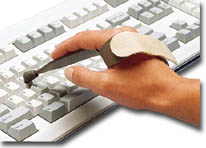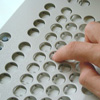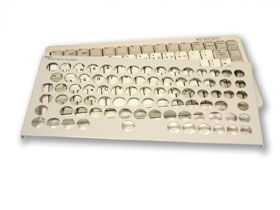Assistive Technology for Computer System Input
As previously discussed in earlier modules, inputting information into a computer system requires an ability to use a keyboard or mouse. People with physical disabilities effecting the use of their hands and fingers typically have difficulty utilizing a standard mouse or keyboard; thus requiring computer access AT to input information into a computer. Types of disabilities that may lead to a necessity for AT for computer access include spinal cord injuries (SCI), Cerebral Palsy, ALS, Muscular Dystrophy, Multiple Sclerosis, repetitive stress injuries (RSI), various neuromuscular disorders, arthritis, amputations, as well as visual impairments among others. The most commonly used AT to assist people access a computer include typing aids, alternative keyboards, alterative mouse options, and alternatives input options such as speech recognition software.
Typing Aids
The most effective means of inputting text-related information into a computer is through the use of a standard keyboard. However, many people with disabilities effecting their hand movements cannot accurately or efficiently use a standard keyboard. When introducing input-based AT, the simplest solution is to use a device that allows the individual with the disability to utilize his or her abilities to access the standard keyboard. Typing aids are AT devices that can be used in this role. Although these devices provide access to a standard keyboard, they do not necessarily provide the same input speed as two-hand typing or some of the input devices that will be discussed later in this module. The category of typing aids consists of hand-strapped typing aids, mouth sticks, head pointers, and key guards. Examples of each typing aid can be seen to the right.
- Hand-Strapped Typing Aid - Hand-strapped typing aids are pencil sized sticks with rubber tips that strap around the palm area of the user's hand (right, left, or both). These provide the user with a rigid point option they can control with the gross motor movement of their hands and arms. These typing aids are primarily used by people who's disability (SCI, ALS, neuromuscular disorders, TBI, RSI, etc.) has effected the fine motor control of their fingers, causing an inability to accurately target or press keys on a standard keyboard.
- Mouth Stick - Mouth sticks are a similar concept to hand-strapped typing aids. They provide the user with a rigid pointing device that, due to the user's disability, is easier for the user to control than their finger. A mouth stick is roughly 8"-12" long and attaches to a retainer-like bite plate that the user holds in his or her mouth to operate the stick. To effectively use a mouth stick, the user must have good head control. A typical user typically has little or no arm control due to his/her disability.
- Head Pointer - A head pointer is similar to a mouth stick except instead of holding the device in one's mouth, it is strapped to the user's head. Control with a head pointer is dependent on the tightness of the strap, thus good head pointer control usually correlates with discomfort. Head pointers also have a degree of dependency because most people who use head pointers rely on someone else to put it on. Those who have used both find greater control and comfort with a mouth stick. A typical head pointer user is similar to a mouth stick user with the added difficulty of unreliable mouth control, a need to breath through one's mouth, or cognitive disabilities preventing the ability to understand the proper use of a mouth stick.
- Key Guard - Unlike the other typing aids, key guards are not used as a replacement for an inability to point with one finger. A key guard is a piece of plastic or wood with holes corresponding to each key that is placed over a keyboard to help isolate each key. This prevents multiple same-time key hits while also directing users to the proper key and improving the user's typing accuracy. Key guards can be used with or without any of the previously mentioned typing aids. A typical user would be someone with an inability to accurately target an individual key on a keyboard due to a fine motor disability.
Typing Aid Examples
|
|
Hand-Strapped Typing Aid |
|
|
Mouth Sticks |
|
|
Head Pointer |
|
|
|
Key Guards |




